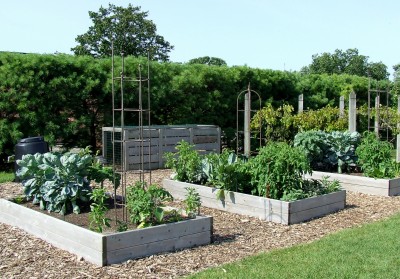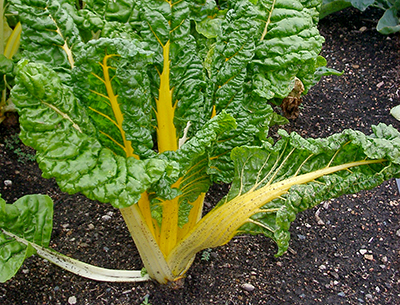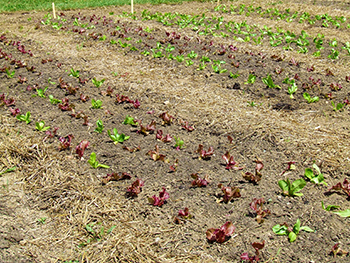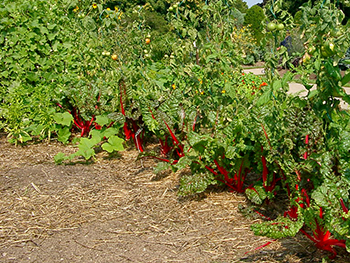
Preparing the smart vegetable garden
DOWNLOADMay 16, 2016 - Rebecca Finneran
Soil preparation
Productive vegetable gardens are based on a strong foundation, and that foundation is the soil. Healthy soils consist of different non-living mineral particles, such as sand, silt and clay, as well as organic matter and living organisms. Healthy soils provide an environment conducive to root growth which leads to a healthy plant and fruit and vegetable production. The Smart Gardening tip sheet “Smart gardens begin with healthy soil” provides complete information about soil specifics.
First, start with a soil test in order to know what nutrients are needed as well as the pH and organic content of the soil. Refer to the Smart Gardening tip sheet “Don’t Guess - Soil Test!” for details on how to do a soil test. Soil tests can be purchased online at the MSU Extension Bookstore (search for E3154).

Once you have the results, you will know what amendments and in what proportion to add for best results in the vegetable garden. Only add the recommended amounts of fertilizer based on the soil test results. Over application of phosphorous and nitrogen fertilizers is a known contaminant of surface and ground water.
Organic matter is also a very important component of your soil as it is the “glue” holding all of the soil components together, providing space for oxygen and good drainage. Organic matter includes composted animal manure, chopped up leaves, grass clippings and cover crops. These are added to sandy soils in order to improve water-holding capacity, and added to clay soils to improve drainage.

Organic residues can easily be seen on the soil surface in the notill gardening system. As time goes on, soils should be crumbly and easy to plant.
Site preparation
If you are breaking ground for a new garden, eliminate grass or weeds that might be in the planned garden area first. One method is to remove the grass or sod by hand. This is most feasible when an instant result is needed. The sod chunks or grass removed can be added to a compost pile and re-entered to the garden system at a later time. However, this method will also require some organic matter be added to the soil below the old turf roots.
There are several methods that employ a “smothering” technique that will accomplish this task without using chemicals. Laying down a sheet of plastic and securing it with weights around the edges will effectively kill vegetation beneath except for the most stubborn of perennial weeds. Another easy way to smother weeds is to place several sheets of newspaper down in the area and layer compost or other organic matter such as chopped up leaves, grass clippings or mulch over the top. This is commonly called “sheet composting.” The organic layers on top will degrade while weeds below are dying out, resulting in a weed-free and ready-to plant-garden space. This may take a few months or can effectively start in the fall with spring planting in mind. Today’s newsprint is made with vegetable-based ink so there are no worries about residues left behind.
No-till preparation
No-till farming and gardening is a method in which the soil is left undisturbed except in the planting space for the seeds or plants. For years farmers have utilized the no-till method for crops, realizing the benefits of erosion control, soil moisture conservation, fewer weeds and building soil structure and health. Excessive tillage destroys the soil structure which is the foundation for healthy plant roots that interact with the living component of the soil.
Adding organic matter also enhances soil structure by encouraging microorganisms to act as a conduit for nutrients to enter plant roots. The no-till technique leaves crop residue on the soil surface which increases the organic matter content of the soil while enhancing the environment for the living component. Many gardeners are utilizing no-till vegetable gardening.
Planning a no-till smart vegetable garden requires a little bit of thought. It is imperative that you don’t walk on the soil in the planting areas as you work in the garden. This will only compact the soil. Therefore, you need to design your garden so that you have paths to walk on between the actual planting areas. The beds should be no more than 4 feet wide so that you can reach across the bed to weed or harvest while kneeling in the walkway. In addition, create beds that are shorter in length so that you are not tempted to cut across the bed to get to another one. A good size bed recommendation is around 4 feet wide by 8 feet long.
The sheet composting method mentioned above can be used to prepare the bed the first year. After that, organic matter such as compost should be added to these beds each season; organic matter breaks down over time and needs to be replenished. One to 2 inches of compost may be all a garden needs for the season. It may take a couple of seasons to build your no-till beds, but once they are established, adding additional organic matter is all that is necessary. Using an organic mulch such as straw or wood landscape mulch will help prevent weeds from growing and can serve double-duty as organic matter; it’s an important component in the no-till garden.


Straw mulch used in walkways will reduce compaction and retard weed growth.
You may want to explore other popular types of no-till systems, including sheet composting, lasagna gardening, straw bale gardens and container gardening.
If you choose a more conventional method of preparing the garden such as with a cultivator, you are encouraged to reduce tilling to a minimum. As mentioned before, tilling breaks down soil structure and disturbs the environment that is beneficial to living organisms, so the less tilling, the better.
The practice of rotating crops in the garden is also a smart tip. This action helps reduce pests and pathogens that may be carried on the same crop from one year to the next. In addition, crops such as beans and other legumes “fix” nitrogen on their roots which will benefit the next plant that gets planted in that space the following season.
For more information on a wide variety of smart gardening articles, or to find out about smart gardening classes and events, visit the Gardening in Michigan website.



 Print
Print Email
Email




